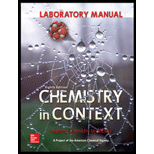
Laboratory Manual Chemistry in Context
8th Edition
ISBN: 9780073518121
Author: American Chemical Society
Publisher: McGraw-Hill Education
expand_more
expand_more
format_list_bulleted
Concept explainers
Question
Chapter 6, Problem 23Q
(a)
Interpretation Introduction
Interpretation:
World is naturally acidic has to be explained.
(b)
Interpretation Introduction
Interpretation:
The way in which human make the world more acidic has to be explained.
(c)
Interpretation Introduction
Interpretation:
Big basic part of our world has to be given.
Expert Solution & Answer
Want to see the full answer?
Check out a sample textbook solution
Students have asked these similar questions
Can I get some help drawing my arrows. I included what the final needs to look like
please help
(a)
(e)
O₂N.
(h)
21.8 Name the following compounds.
Br
(f)
Ph.
(c)
(d)
Br
(g)
NO₂
H
NH2
Br
mo. 0-0.
OMe
(i)
Chapter 6 Solutions
Laboratory Manual Chemistry in Context
Ch. 6.1 - Although the word acid may conjure up all sorts of...Ch. 6.2 - Prob. 6.4YTCh. 6.4 - Prob. 6.8YTCh. 6.4 - Prob. 6.10CTCh. 6.5 - In 2008, a group of scientists met in Monaco to...Ch. 6.6 - Prob. 6.13YTCh. 6.9 - Prob. 6.15YTCh. 6.9 - Prob. 6.16YTCh. 6.10 - Prob. 6.17YTCh. 6.11 - Prob. 6.18YT
Ch. 6.11 - Prob. 6.19YTCh. 6.11 - Prob. 6.21YTCh. 6.11 - Prob. 6.22YTCh. 6.12 - Prob. 6.25YTCh. 6.12 - Prob. 6.26YTCh. 6 - Prob. 6.1YTCh. 6 - Prob. 1QCh. 6 - Prob. 2QCh. 6 - Prob. 3QCh. 6 - Prob. 4QCh. 6 - Prob. 5QCh. 6 - Prob. 6QCh. 6 - Prob. 7QCh. 6 - Prob. 8QCh. 6 - Prob. 9QCh. 6 - Which gas is dissolved in water to produce each of...Ch. 6 - Consider these ions: nitrate, sulfate, carbonate,...Ch. 6 - Prob. 12QCh. 6 - In each pair below, the [H+] is different. By what...Ch. 6 - Classify the following aqueous solutions as...Ch. 6 - Prob. 15QCh. 6 - Which of these has the lowest concentration of...Ch. 6 - Prob. 17QCh. 6 - Prob. 18QCh. 6 - Prob. 19QCh. 6 - Prob. 20QCh. 6 - Prob. 21QCh. 6 - Prob. 22QCh. 6 - Prob. 23QCh. 6 - Prob. 24QCh. 6 - Prob. 25QCh. 6 - Prob. 26QCh. 6 - Prob. 27QCh. 6 - Prob. 28QCh. 6 - Prob. 29QCh. 6 - Prob. 30QCh. 6 - Prob. 31QCh. 6 - Prob. 32QCh. 6 - Prob. 33QCh. 6 - Prob. 34QCh. 6 - Prob. 35QCh. 6 - Prob. 36QCh. 6 - Prob. 37QCh. 6 - Prob. 38QCh. 6 - Prob. 39QCh. 6 - Prob. 40QCh. 6 - Prob. 41QCh. 6 - Prob. 42QCh. 6 - Prob. 43QCh. 6 - Prob. 44QCh. 6 - Prob. 45QCh. 6 - Prob. 46QCh. 6 - Prob. 47QCh. 6 - Prob. 48QCh. 6 - Prob. 49QCh. 6 - Prob. 50QCh. 6 - Prob. 51QCh. 6 - Prob. 52QCh. 6 - Prob. 53QCh. 6 - Prob. 55QCh. 6 - Prob. 56Q
Knowledge Booster
Learn more about
Need a deep-dive on the concept behind this application? Look no further. Learn more about this topic, chemistry and related others by exploring similar questions and additional content below.Similar questions
- Can I get helpp drawing my arrowsarrow_forwardWhich of the m/z values corresponds to the base peak in the mass spectrum shown? 100 80 A. 45 B. 44 C. 29 D. 15 Intensity 20 0 10 20 30 40 B- m/z -8 50 E. 30 Which of the m/z values correspond to the molecular ion for the compound shown? A. 18 B. 82 OH C. 100 D. 102 E. 103arrow_forwardCan someone help me with drawing my arrows.arrow_forward
- I'm having trouble with converting lewis diagrams into VSEPR diagrams. I currently have this example of C2BrCl3 which I want to turn into a lewis structure, but I'm not sure what steps I need to do in order to do so. I have the table written down, however, there's two central atoms so what would I do? There seems to be 4 electron domains on the carbon atom and no lone pairs so it would seem like this shape would be tetrahedral. Here's what I have now. Thanks!arrow_forwardWe discussed the solid phase resin using in peptide synthesis. Provide a mechanism, for its formation. DRAW THE MECHANISM.arrow_forwardPlease help. Every time I've asked an expert in the past, it's been wrong :(arrow_forward
arrow_back_ios
SEE MORE QUESTIONS
arrow_forward_ios
Recommended textbooks for you
 ChemistryChemistryISBN:9781305957404Author:Steven S. Zumdahl, Susan A. Zumdahl, Donald J. DeCostePublisher:Cengage Learning
ChemistryChemistryISBN:9781305957404Author:Steven S. Zumdahl, Susan A. Zumdahl, Donald J. DeCostePublisher:Cengage Learning ChemistryChemistryISBN:9781259911156Author:Raymond Chang Dr., Jason Overby ProfessorPublisher:McGraw-Hill Education
ChemistryChemistryISBN:9781259911156Author:Raymond Chang Dr., Jason Overby ProfessorPublisher:McGraw-Hill Education Principles of Instrumental AnalysisChemistryISBN:9781305577213Author:Douglas A. Skoog, F. James Holler, Stanley R. CrouchPublisher:Cengage Learning
Principles of Instrumental AnalysisChemistryISBN:9781305577213Author:Douglas A. Skoog, F. James Holler, Stanley R. CrouchPublisher:Cengage Learning Organic ChemistryChemistryISBN:9780078021558Author:Janice Gorzynski Smith Dr.Publisher:McGraw-Hill Education
Organic ChemistryChemistryISBN:9780078021558Author:Janice Gorzynski Smith Dr.Publisher:McGraw-Hill Education Chemistry: Principles and ReactionsChemistryISBN:9781305079373Author:William L. Masterton, Cecile N. HurleyPublisher:Cengage Learning
Chemistry: Principles and ReactionsChemistryISBN:9781305079373Author:William L. Masterton, Cecile N. HurleyPublisher:Cengage Learning Elementary Principles of Chemical Processes, Bind...ChemistryISBN:9781118431221Author:Richard M. Felder, Ronald W. Rousseau, Lisa G. BullardPublisher:WILEY
Elementary Principles of Chemical Processes, Bind...ChemistryISBN:9781118431221Author:Richard M. Felder, Ronald W. Rousseau, Lisa G. BullardPublisher:WILEY

Chemistry
Chemistry
ISBN:9781305957404
Author:Steven S. Zumdahl, Susan A. Zumdahl, Donald J. DeCoste
Publisher:Cengage Learning

Chemistry
Chemistry
ISBN:9781259911156
Author:Raymond Chang Dr., Jason Overby Professor
Publisher:McGraw-Hill Education

Principles of Instrumental Analysis
Chemistry
ISBN:9781305577213
Author:Douglas A. Skoog, F. James Holler, Stanley R. Crouch
Publisher:Cengage Learning

Organic Chemistry
Chemistry
ISBN:9780078021558
Author:Janice Gorzynski Smith Dr.
Publisher:McGraw-Hill Education

Chemistry: Principles and Reactions
Chemistry
ISBN:9781305079373
Author:William L. Masterton, Cecile N. Hurley
Publisher:Cengage Learning

Elementary Principles of Chemical Processes, Bind...
Chemistry
ISBN:9781118431221
Author:Richard M. Felder, Ronald W. Rousseau, Lisa G. Bullard
Publisher:WILEY
General Chemistry | Acids & Bases; Author: Ninja Nerd;https://www.youtube.com/watch?v=AOr_5tbgfQ0;License: Standard YouTube License, CC-BY